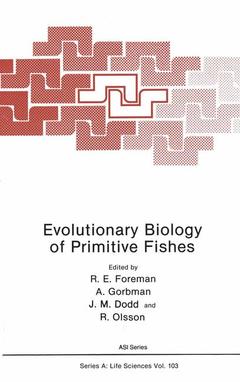Description
Evolutionary Biology of Primitive Fishes, Softcover reprint of the original 1st ed. 1985
NATO Science Series A: Series, Vol. 103
Authors: Foreman R. E., Gorbman A., Dodd J. M., Olsson R.
Language: English
Keywords
biology; development; evolution; evolutionary biology; physiology
105.49 €
In Print (Delivery period: 15 days).
Add to cart
Publication date: 11-2012
463 p. · 17.8x25.4 cm · Paperback
463 p. · 17.8x25.4 cm · Paperback
Description
/li>Contents
/li>
What, precisely, is a primitive fish? Most biologists would agree that the living cyclostomes, selachians, crossopterygians, etc. cannot be considered truly primitive. However, they and the fossil record have served to provide the information which forms the basis for speculation concerning the nature of the original vertebrates. This symposium of biologists from a variety of disciplines was called together to create collectively, from the best available current evidence, a picture of the probable line of evolution of the prototype primitive fishes. The symposium was designed to follow one that took place in Stockholm in 1967, convened for a similar purpose, with about the same number of participants. It is a matter of interest that almost the entire 1967 symposium (Nobel Symposium 4) dealt only with the hard tissues, whether fossil or modern. In charting the course of the present symposium it was felt that the intervening years have produced numerous lines of new evidence that could be employed in the same way that a navigator determines his position. Each field, be it adult morphology, geology, ecology, biochemistry, development or physiology, generates evidence that can be extrapolated backward from existing vertebrate forms and forward from invertebrate forms. If the intersect of only two lines of evidence produces a navigational "fix" of rather low reliability, then an intersect, however unfocussed, of multiple guidelines from more numerous disciplines might provide a better position from which to judge early vertebrate history.
Scenarios: Why?.- General Ecology of Primitive Fishes.- Facts and Thoughts on Piscine Phylogeny.- Reconstructing the Life Cycle and the Feeding of Ancestral Vertebrates.- Habitat, Phylogeny and the Evolution of Osmoregulatory Strategies in Primitive Fishes.- The Brain and Sense Organs of the Earliest Vertebrates: Reconstruction of a Morphotype.- The Lateral Line System of Cyclostomes.- Freshwater Parasitic Lamprey on Vancouver Island and a Theory of the Evolution of the Freshwater Parasitic and Nonparasitic Life History Types.- Organ Development and Specialization in Lamprey Species.- Early Development of Oral, Olfactory and Adenohypophyseal Structures of Agnathans and Its Evolutionary Implications.- Immunologic Relations Among Fish Groups.- Evolution of Temperature Regulation and of Constancy of Function (Homeokinesis) at Different Temperatures.- Respiration in Phyletically Ancient Fishes.- Regulation of Blood and Body Fluids in Primitive Fish Groups.- Evolution of the Renin-Angiotensin System and Its Role in Control of Cardiovascular Function in Fishes.- Evolutionary Aspects of Reproduction in Cyclostomes and Cartilaginous Fishes.- On Urea Formation in Primitive Fishes.- Some Aspects of Hormonal Regulation of Metabolism in Agnathans.- Hagfish Insulin: Evolution of Insulin.- Evolution of Gastro-Entero-Pancreatic Endocrine Systems in Lower Vertebrates.- Functional Evolution of Gastrointestinal Hormones.- Hormonal Peptide Evolution.- Tissue Distribution of Hormonal Peptides in Primitive Fishes.- Group Photo.- Contributors and Participants.
© 2024 LAVOISIER S.A.S.




